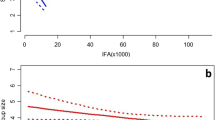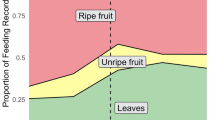Abstract
Socioecological theory proposes that the flexibility in grouping patterns afforded by fission–fusion dynamics allows animals to cope with spatiotemporal variability in food abundance. We investigate the influence of fruit tree abundance and foraging environment heterogeneity on fission–fusion dynamics in a group of spider monkeys (Ateles geoffroyi) in the Yucatan peninsula, Mexico. We collected 1300 h of behavioral data and 23 samples of biweekly ecological data from August 2009 to July 2010. We measured fission–fusion dynamics through the temporal variation in the size and composition of subgroups, the spatial dispersion within and between subgroups, and the frequency of fissions and fusions. We measured habitat-wide food abundance of preferred species, including two that differ greatly in their relative abundance: Brosimum alicastrum (a hyperabundant resource) and Ficus spp. (a not so abundant resource but often represented by large trees). We evaluated the foraging environment heterogeneity through the variance in the number of trees with fruit between species. Our results show that, although habitat-wide food abundance is important, the availability of key resources strongly influences the spider monkeys’ fission–fusion dynamics. When there was a high abundance of fruit of Brosimum, subgroups tended to be more stable, smaller, and mixed sex, and their members remained close. In contrast, when Brosimum trees with fruit were scarce, females often formed large, more fluid and dispersed subgroups. Foraging environment heterogeneity had a positive effect on within-subgroup spatial dispersion and rates of fission and fusion. The complex relationships we have uncovered suggest that the flexibility afforded by fission–fusion dynamics is an adaptation to highly variable foraging environments.





Similar content being viewed by others
References
Asensio, N., Korstjens, A. H., & Aureli, F. (2009). Fissioning minimizes ranging costs in spider monkeys: a multiple level approach. Behavioral Ecology and Sociobiology, 63, 649–659.
Aureli, F., & Schaffner, C. M. (2007). Aggression and conflict management at fusion in spider monkeys. Biology Letters, 3, 147–149.
Aureli, F., Schaffner, C. M., Boesch, C., Bearder, S. K., Call, J., et al (2008). Fission–fusion dynamics: new research frameworks. Current Anthropology, 49, 627–654.
Aureli, F., Schaffner, C. M., Asensio, N., & Lusseau, D. (2012). What is a subgroup? How socioecological factors influence interindividual distance. Behavioral Ecology, 23(6), 1308–1315.
Bates, D., Maechler, M., Bolker, B., & Walker, S. (2015). Fitting linear mixed-effects models using lme4. Journal of Statistical Software, 67, 1–48.
Bolker, B. M., Brooks, M. E., Clark, C. J., Geange, S. W., Poulsen, J. R., et al (2009). Generalized linear mixed models: a practical guide for ecology and evolution. Trends in Ecology and Evolution, 24, 127–135.
Bonilla-Moheno, M. (2008). Forest recovery and management options in the Yucatan Peninsula, Mexico. Ph.D. thesis, University of California, Santa Cruz.
Breheny, P., & Burchett, W. (2016). Visreg: visualization of regression models. R package version 2.3.0.
Cairns, S. J., & Schwager, S. J. (1987). A comparison of association indexes. Animal Behaviour, 35, 1454–1469.
Chapman, C. A., Wrangham, R. W., & Chapman, L. J. (1995). Ecological constraints on group size: an analysis of spider monkey and chimpanzee subgroups. Behavioral Ecology and Sociobiology, 36, 59–70.
Chapman, C. A., Chapman, L. J., Zanne, A. E., Poulsen, J. R., & Clark, C. J. (2005). A 12-year phenological record of fruiting: implications for frugivore populations and indicators of climate change. In J. L. Dew & J. P. Boubli (Eds.), Tropical fruits and frugivores: the search for strong interactions (pp. 75–92). New York: Springer Science+Business Media.
Core Team, R. (2012). R: a language and environment for statistical computing. Vienna: R Foundation for Statistical Computing.
Di Fiore, A., & Suarez, S. A. (2007). Route-based travel and shared routes in sympatric spider and wooly monkeys: cognitive and evolutionary implications. Animal Cognition, 10, 317–329.
Di Fiore, A., Link, A., & Dew, J. L. (2008). Diets of wild spider monkeys. In C. J. Campbell (Ed.), Spider monkeys: Behavior, ecology and evolution of the genus Ateles (pp. 81–137). New York: Cambridge University Press.
García-Frapolli, E., Ayala-Orozco, B., Bonilla-Moheno, B., Espadas-Manrique, C., & Ramos-Fernández, G. (2007). Biodiversity conservation, traditional agriculture and ecotourism: land cover/land use change projections for a natural protected areas in the northeastern Yucatan peninsula, Mexico. Landscape and Urban Planning, 83, 137–153.
González-Zamora, A., Arroyo-Rodríguez, A., Chaves, O. M., Sánchez-López, S., Stoner, K. E., & Riba-Hernández, P. (2009). Diet of spider monkeys (Ateles geoffroyi) in Mesoamerica: current knowledge and future directions. American Journal of Primatology, 71, 8–20.
Hartwell, K. S., Notman, H., Bonenfant, C., & Pavelka, M. S. M. (2014). Assessing the occurrence of sexual segregation in spider monkeys (Ateles geoffroyi yucatanensis), its mechanisms and function. International Journal of Primatology, 35, 425–444.
Irwin, M. T. (2007). Living in forest fragments reduces group cohesion in diademed Sifakas (Propithecus diadema) in eastern Madagascar by reducing food patch size. American Journal of Primatology, 69, 434–447.
Janson, C. H., & Goldsmith, M. L. (1995). Predicting group size in primates: foraging costs and predation risks. Behavioral Ecology, 6, 326–336.
Kerth, G. (2010). Group decision-making in animal societies. In P. Kappeler (Ed.), Animal behaviour: Evolution and mechanisms (pp. 241–265). Berlin and Heidelberg: Springer-Verlag.
King, A., & Cowlishaw, G. (2007). When to use social information: the advantage of large group size in individual decision making. Biology Letters, 3, 137–139.
Koenig, A., Scarry, C. J., Wheeler, B. C., & Borries, C. (2013). Variation in grouping patterns, mating system and social structure: what socioecological models attempt to explain. Philosophical Transactions of the Royal Society B: Biological Sciences, 368, 20120348.
Martin, P., & Bateson, P. B. (1993). Measuring behaviour: an introductory guide (2nd ed.). Cambridge: Cambridge University Press.
Ramos-Fernandez, G. (2005). Vocal communication in a fission–fusion society: do spider monkeys stay in touch with close associates? International Journal of Primatology, 26, 1077–1092.
Ramos-Fernandez, G., & Ayala-Orozco, B. (2003). Population size and habitat use of spider monkeys at Punta Laguna, Mexico. In L. K. March (Ed.), Primates in fragments: ecology and conservation (pp. 191–209). New York: Kluwer Academic/Plenum.
Ramos-Fernandez, G., Vick, L. G., Aureli, F., Schaffner, C. M., & Taub, D. M. (2003). Behavioral ecology and conservation status of spider monkeys in the Otoch Ma’ax Yetel Kooh protected area. Neotropical Primates, 11(3), 155–158.
Ramos-Fernandez, G., Mateos, J. L., Miramontes, O., Larralde, H., Cocho, G., & Ayala-Orozco, B. (2004). Lévy walk patterns in the foraging movements of spider monkeys (Ateles geoffroyi). Behavioral Ecology and Sociobiology, 55, 223–230.
Ramos-Fernandez, G., Boyer, D., & Gómez, V. P. (2006). A complex social structure with fission–fusion properties can emerge from a simple foraging model. Behavioral Ecology and Sociobiology, 60, 536–549.
Ramos-Fernandez, G., Boyer, D., Aureli, F., & Vick, L. (2009). Association networks in spider monkeys (Ateles geoffroyi). Behavioral Ecology and Sociobiology, 63, 999–1013.
Ramos-Fernandez, G., Pinacho-Guendulain, B., Miranda-Pérez, A., & Boyer, D. (2011). No evidence of coordination between different subgroups in the fission–fusion society of spider monkeys (Ateles geoffroyi). International Journal of Primatology, 32, 1367–1382.
Ramos-Fernandez, G., Smith-Aguilar, S. E., Schaffner, C. M., Vick, L. G., & Aureli, F. (2013). Site fidelity in space use by spider monkeys (Ateles geoffroyi) in the Yucatan peninsula, Mexico. PloS One, 8, e62813.
Rimbach, R., Link, A., Montes-Rojas, A., Di Fiore, A., Heistermann, M., & Heymann, E. W. (2014). Behavioral and physiological responses to fruit availability of spider monkeys ranging in a small forest fragment. American Journal of Primatology, 76, 1049–1061.
Russo, E. S., Campbell, C. J., Dew, J. L., Stevenson, P. R., & Suarez, S. A. (2005). A multi-forest comparison of dietary preferences and seed dispersal by Ateles spp. International Journal of Primatology, 26, 1017–1037.
Schreier, A. L., & Swedell, L. (2012). Ecology and sociality in a multilevel society: ecological determinants of spatial cohesion in hamadryas baboons. American Journal of Physical Anthropology, 148, 580–588.
Shimooka, Y. (2003). Seasonal variation in association patterns of wild spider monkeys (Ateles belzebuth belzebuth) at La Macarena, Colombia. Primates, 44, 83–90.
Slater, K. Y., Schaffner, C. M., & Aureli, F. (2009). Sex differences in the social behavior of wild spider monkeys (Ateles geoffroyi yucatanensis). American Journal of Primatology, 71, 21–29.
Smith-Aguilar, S. E., Ramos-Fernandez, G., & Getz, W. M. (2016). Seasonal changes in socio-spatial structure in a group of free-living spider monkeys (Ateles geoffroyi). PloS One, 11(6), e0157228.
Sorensen, T. C., & Fedigan, L. M. (2000). Distribution of three monkey species along a gradient of regenerating tropical dry forest. Biological Conservation, 92, 227–240.
Sterck, E., Watts, D. P., & van Schaik, C. P. (1997). The evolution of female social relationships in nonhuman primates. Behavioral Ecology and Sociobiology, 41, 291–309.
Stevenson, P. R., Quiñones, M. J., & Ahumada, J. A. (1998). Effects of fruit patch availability on feeding subgroup size and spacing patterns in four primate species at Tinigua National Park, Colombia. International Journal of Primatology, 19, 313–324.
Sueur, C., King, A. J., Conradt, L., Kerth, G., Lusseau, D., Mettke-Hofmann, et al. (2011). Collective decision-making and fission–fusion dynamics: a conceptual framework. Oikos, 120, 1608–1617.
Sugiura, H., Shimooka, Y., & Tsuji, Y. (2011). Variation in spatial cohesiveness in a group of Japanese macaques (Macaca fuscata). International Journal of Primatology, 32, 1348–1366.
Symington, M. M. (1988). Food competition and foraging party size in the black spider monkey (Ateles paniscus chamek). Behaviour, 105, 117–134.
Symington, M. M. (1990). Fission–fusion social organization in Ateles and Pan. International Journal of Primatology, 11, 47–61.
Symonds, M. R. E., & Moussalli, A. (2011). A brief guide to model selection, multimodel inference and model averaging in behavioural ecology using Akaike’s information criterion. Behavioral Ecology and Sociobiology, 65, 13–21.
Valero, A., & Byrne, R. W. (2007). Spider monkey ranging patterns in Mexican subtropical forest: do travel routes reflect planning? Animal Cognition, 10, 305–315.
Vogel, E. R., & Janson, C. H. (2011). Quantifying primate food distribution and abundance for socioecological studies: an objective consumer-centered method. International Journal of Primatology, 32, 737–754.
Acknowledgements
We thank Eulogio, Macedonio, Augusto, and Juan Canul for their invaluable assistance during the collection of field data; the people of Punta Laguna for all their support; Filippo Aureli, Laura Vick, and Colleen M. Schaffner for sharing the management of the field project in Punta Laguna; and Sandra Smith Aguilar, Adriana Aguilar, and Tania Palacios for suggestions that improved the manuscript. We also thank Joanna M. Setchell and two anonymous reviewers for their invaluable comments and suggestions that helped us substantially improve the final version of our article. Finally, we thank CONACYT (projects J51278 and 157656 and a M.Sc. scholarship to B. Pinacho-Guendulain) and the Instituto Politécnico Nacional for financial support.
Author information
Authors and Affiliations
Corresponding author
Ethics declarations
Conflicts of interest
The authors declare that they have no conflict of interest.
Additional information
Handling Editor: Joanna M. Setchell
Electronic supplementary material
Supporting information about the diet of our study group (ESM Table SI), temporal variation of two key resources for the diet of spider monkeys (ESM Fig. S1), results of the GLMMs (ESM Table SII), and the observed temporal variation of fission–fusion dynamics in spider monkeys (ESM Figs. S2–S7) are available online.
ESM 1
(DOCX 353 kb)
Rights and permissions
About this article
Cite this article
Pinacho-Guendulain, B., Ramos-Fernández, G. Influence of Fruit Availability on the Fission–Fusion Dynamics of Spider Monkeys (Ateles geoffroyi). Int J Primatol 38, 466–484 (2017). https://doi.org/10.1007/s10764-017-9955-z
Received:
Accepted:
Published:
Issue Date:
DOI: https://doi.org/10.1007/s10764-017-9955-z




